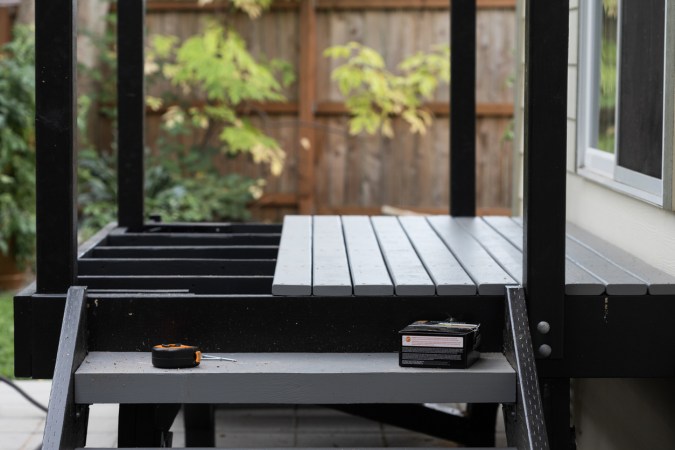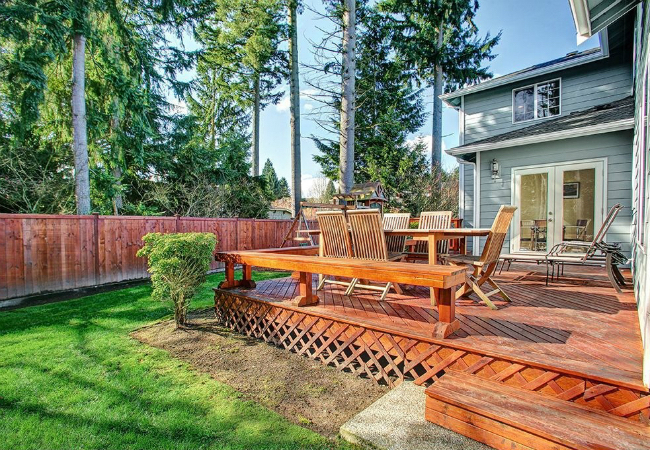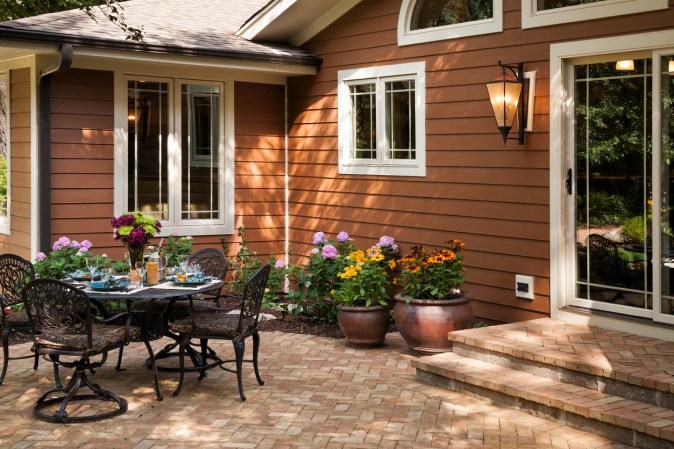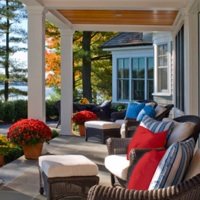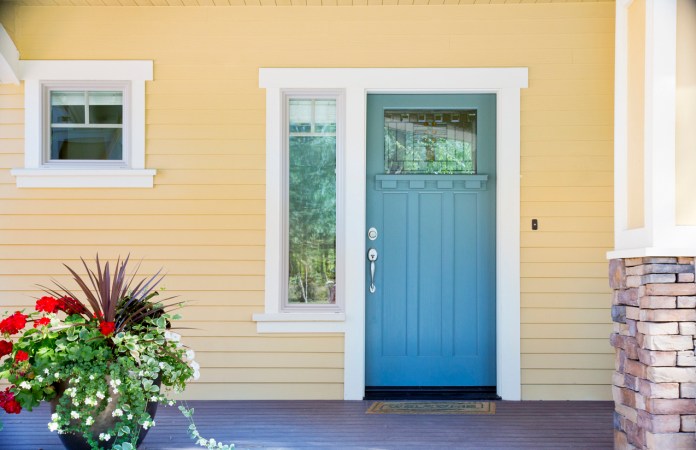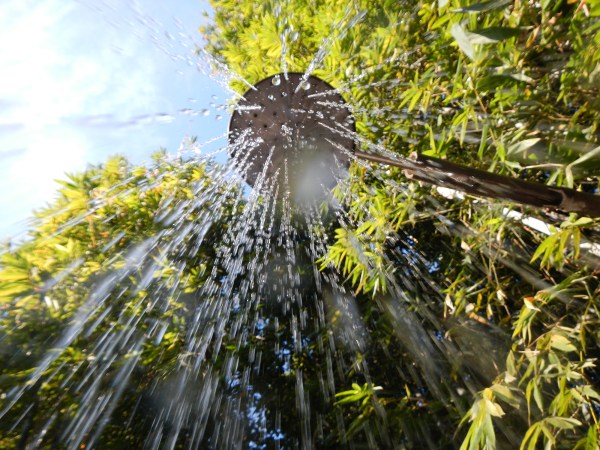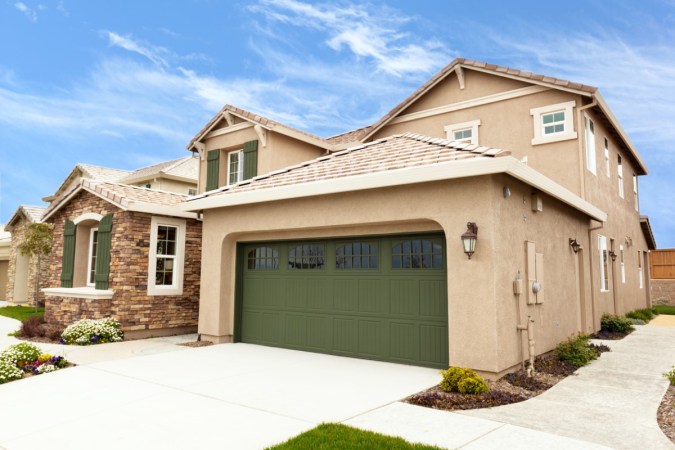We may earn revenue from the products available on this page and participate in affiliate programs. Learn More ›
Deck building is on the rise. According to a 2011 report by The Freedonia Group, leading business researchers, “U.S. demand for decking is forecast to rise 2.7 percent annually through 2014.”
Why? “From the lifestyle perspective, there’s great value in adding an outdoor living space,” says Bob Mion, the California Redwood Association’s marketing director. In addition to “enhancing the quality and quantity of living space in your yard,” he adds, “you can build a deck knowing you’ll recoup, on average, 82 percent of the project’s cost when you sell your home.”
As a priority, location, location, location is now being replaced by space, space, space, as homeowners strive to utilize every inch of their land. A deck, one way to maximize even the tiniest backyard plot, can be any size, shape or configuration as long as it conforms to the geography of the land and a home’s style and profile. But, the size, scale, location and materials will impact on everything from cost to long-term enjoyment, so plan wisely.
Deck building is certainly a DIY endeavor provided you have better than average building skills and keep the plan simple. You can find a variety of free deck plans on line, along with some web-based tools that will help you customize your plans to exact specifications. Your local lumber yard and home center can also provide expert advice and support.
If the job of installing a deck is outside your DIY comfort level, there are plenty of contractors, carpenters, and installation service providers that can help you envision, design, install and realize your dream deck.
Regardless of whether you choose to build the deck yourself or hire a professional, you should acquaint yourself with the basics. This guide will familiarize you with everything you need to know about outdoor decks from planning and wood varieties to seasonal care and long-term maintenance.
Planning Your Dream Deck
When considering a deck, think how you’ll use it. If you like cooking outdoors, you’ll want it attached to your house near the kitchen. If you entertain alfresco, site it just off your family room. A deck can serve as a bridge from the house to the pool or as an extension of the existing pool surround. It can also offer an attractive solution to a sloping yard and make the most of uneven terrain. But, if the deck is mainly a place to rest and relax, it could be freestanding—just about anywhere on your property.
To get the most from your planning, consider the following:
Plan from the inside out.
Imagine how a deck would extend outward from your home. Will it lead to a garden? A lawn? A pool? Could it exploit a pleasing view? After deciding where to build it, use lengths of rope to lay out various sizes and shapes so you can experience what the deck really should be.
Consider the deck from the outside.
There are a variety of deck styles to choose from, but you will want to design one that blends naturally with your home’s architectural style and color palette. Remember that a deck is part of both the house and the landscape, so make it meet your requirements in terms of function and aesthetics. And, don’t overlook shade considerations. If your site lacks trees, you may want to add a shade covering, or consider trellising or pergola-like beams to provide a built-in solution.
Is a building permit required?
Depending on where you live and the size of the deck you want, you may need to get a permit. Check with your local building department. It’s always better to be safe than sorry—or penalized.
Consult a pro.
Unless you feel confident of your DIY skills, consider engaging a local landscape architect or deck builder. Talk with at least three—until you find one who shares your vision and respects your budget. Be sure to check references and don’t hesiate contacting the Better Business Bureau and local Chamber of Commerce. Before hiring anyone, make sure your needs are well documented.
Selecting Deck Materials
There are many wood species that can be used for outdoor decks, but not all offer the same benefits and maintenance requirements. Price and availability vary regionally. As California Redwood Association’s Bob Mion points out, “In the Southeast you’ll find lots of Southern yellow pine; in the North Central Midwest, Western red cedar; in the California-Oregon-Washington region, redwood predominantly.” You can certainly use redwood for a deck on Cape Cod—if you pay to ship it there.
Knowing that where you live and how much you can spend may be deciding factors—here are the likeliest natural wood chioces for deck building:
- Redwood is easy to work with, naturally decay- and insect-resistant and rugged enough to avoid warping and splitting.
- Cedar resists moisture, rot and insect infestation. If untreated, it weathers to a silvery gray but is easily stained or sealed.
- Douglas fir, like spruce, is not only a source of beauty but also very strong. It responds well to hand- and power-tool use and, properly treated, is decay-, mold- and termite-resistant.
- Cypress is strong, with natural resistance to decay. It’s also easy to work with—either with hand or power tools.
- Hemlock boasts a uniform wood grain as well as a natural resistance to decay. It, too, is easily dealt with.
- Southern yellow pine, when pressure-treated, is durable, strong and environmentally friendly. NOTE: In 2003, when high toxicity was discovered in pressure-treated wood, new regulations were established. Manufacturers now use nontoxic chemicals to make that product safe as well as rot- and insect-repellant. Decking experts at The Home Depot say that “pressure-treated lumber provides greater strength and is less expensive than other deck materials. Use it to frame the structure, then choose another material for decking and railings.”
- Exotic wood choices. These species are more durable, more difficult to work with and more expensive,” says The Home Depot. Choices include cambara, meranti and ipe´, also called Brazilian walnut, which Bob Vila calls “an extremely dense material and also a renewable product—one of the best choices for outdoor decking.”
Finishes, Sealers, and Paints
Unfinished wood will weather naturally, but to prolong its color and longevity, consider applying one of the many protective finishes now on the market. Here are the options, their characteristics and benefits:
Clear water sealer
This transparent finish will provide dampness protection for the wood without altering it’s natural color or grain. It is perfect for all wood types, especially those with built-in color and natural beauty, like redwood and cedar. A recoat is recommended every three years.
Tinted waterproofer
Tinted waterproofer provides dampness protection with the added benefit of color enhancement. Products like Thompson® WaterSeal® are formulated to even out the color differences caused by aging and shield your deck from fade-inducing UV rays. Long-term protection recommends that you recoat every three years.
Semi-transparent stains
Semi-transparent stains (like those from Cabot) contain a light pigmentation designed to enhance the natural grain and character of any wood variety. Unlike paint, stain actually soaks into the grain of the wood, but will fade over time. Consider recoating every couple of years to maintain true beauty.
Solid stain
Solid stain offers a rich, opague finish that covers wood completely like paint, but with the adhering benefits of a stain. In addition to wood tones, there are color options—like blues, greens and reds—that can add a dramatic look to any deck. Best of all solid stains provide decade-long protection from sun and weather.
Paint
Paint is a consideration for less expensive grades of wood, primarily pine. Be sure to prime your deck before brushing on an exterior product, like Behr Porch Paints—an acrylic latex that is mildrew resistant and designed to resist scuffing, fading, cracking and peeling while providing a durable, long-lasting exterior finish. Paint will need recoating every five years depending on traffic wear and deck care.
Floating Deck Care and Maintenance
Regardless of how you finish your wood deck, maintenance is essential—and, in some cases, as easy as wielding a broom.
Seasonally
Sweep away leaves, needles, twigs and branches. Remove debris buildup between boards; it can impede ventilation, causing moisture and standing water to remain on the surface and aid mildew growth.
Annually
Clean thoroughly with deck detergent from a home center or hardware store. Mix according to label instructions and spray on, then let stand 10 to 15 minutes. Use a stiff brush to remove stubborn dirt and grime.
After cleaning, allow two to three days for drying. If you decide to refresh or change your color, apply stain followed by at least one coat of waterproof sealer.
Spot Cleaning
Banish mildew as soon as you see it. Untreated, it can create permanent deck damage. Home centers sell various mildew removers, but the Western Red Cedar Lumber Association suggests mixing your own: In a pump-style garden sprayer combine 3 quarts of cold water, 12 quarts of oxygen bleach and ¼ cup of ammonia-free liquid dish detergent. Spray liberally and let set 10 to 15 minutes, then rinse with clear, cold water. For tough stains, apply this solution with a soft bristle brush, or scrub with straight vinegar. Rinse; when dry, finish with two coats of sealer.
